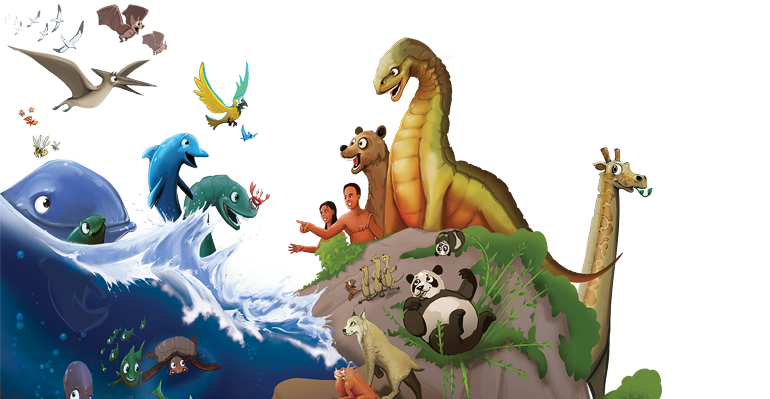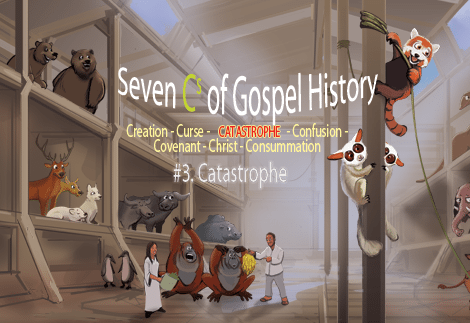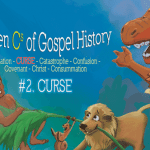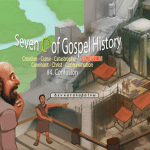
After Adam and Eve had disobeyed God by eating the fruit that God had commanded them not to eat, God sent them to live outside the Garden of Eden. Here they had lots of children, who grew up and had lots of children, who grew up and had lots of children. Most of these people did not love and obey God, but only thought and did evil things all the time. Things got so bad that God was sorry He had made man. After about 1,500 years, only one man, Noah, worshiped God and obeyed Him.
Building the Ark
One day God told Noah He was going to send a flood that would cover the whole earth. God told Noah to build a huge Ark—this was to save alive some of the animals, along with Noah’s family to repopulate the earth after the Flood. The Ark measured about 140 x 23 x 13.5 meters or 450 x 75 x 45 feet. This is longer than a football field, as wide as four traffic lanes, and a little higher than a four-floor building. It had three decks, lots of rooms for all the animals and their food, a roof to keep the rain out, and a full-length opening at the top to let in light and fresh air.
People there could see the huge Ark taking shape as Noah and his sons built it, but no one heeded Noah’s warning that a Flood was coming, and when it did, they would have to be aboard the Ark to be saved.
All aboard!
After many, many years, it was all ready. God sent the animals and birds to Noah—a pair of most animals, but seven pairs of a few kinds (the ‘clean’ animals that could be used for sacrifices—later these animals would be the only ones the Hebrews could eat). Was there room for them all? Yes, there were only several thousand animals in all. That’s because many of the animals that went on the Ark produced many species of animals after the Flood. For instance, the wolf, the coyote, the dingo, the jackal, and the dogs that you might have as pets all came from a single pair that entered the Ark. And the lion, the panther, the cheetah, and the tiger probably all come from a single pair that was on the Ark.
Noah also took pairs of the different kinds of dinosaurs, whose ancestors God had created on Day 6 of Creation Week, along with the other animals. There was room for even the biggest dinosaurs, as these may have come on board before they were fully grown. There were probably about 50 kinds of dinosaurs on the Ark. But of course, Noah didn’t need to take any animals that live in the water, like fish and whales and crabs. And he didn’t have to take insects because they don’t breathe through nostrils (Genesis 7:22). There could have been some on the Ark as ‘stowaways’, but some could have also survived outside the Ark.
What about animals that now live in far-away places, like kangaroos and penguins? The Flood changed the earth’s surface—before the Flood, there was only one continent, not the seven we have now. So all the animals would have been living on the same land area as Noah.
The whole earth covered by water
When Noah and his family and all the animals were aboard, God sent the water. First, it came from “the great deep”—from huge reservoirs deep below the ocean and land. Then it was the hardest rain ever seen—for forty days and forty nights! Everything that breathed and lived on dry land died. Only Noah was left, and those who were with him in the Ark (Genesis 7:22–23).
The Flood lasted about a year. So where did the water go? Here is something to think about: imagine that the earth’s surface were completely smooth—all the mountains flattened and the ocean basins raised to the same level. All the water in the oceans today would cover the whole surface to 3 km (2 miles) deep. So there is plenty of water to cover the whole globe—it just had to be more even.
The Bible says that “the mountains rose, the valleys sank down” (Psalm 104:8). This indicates that there were huge earth movements at that time that caused the mountains we see today to be pushed up to their present height. There are seashells at the top of Mt Everest and many other mountains, showing that they were once under the waters of Noah’s Flood. All this uplift caused oceans of water to flow off the land into deep basins that sank down in the sea. It also caused huge changes in the earth’s surface. And when the waters came down enough, Noah’s Ark grounded on the ‘mountains of Ararat’, though we don’t know exactly where that is today.

Out they all came
When the earth at last was dry and producing vegetation again, God told Noah to come out of the Ark and to bring out all the animals and birds. In time, they all had families that had families that had families, to replace the animals and birds that had died in the Flood. They moved towards Europe, Africa, and Asia. Some of these eventually reached the land we now know as Australia. Others crossed the land bridge to North America, and in time continued on down to South America. All this was possible because, after the Flood, there was an Ice Age that locked up huge quantities of water as ice on the land. This lowered the sea-level, exposing long land-bridges which the animals could cross.
Noah offered a sacrifice to God to thank Him for protecting them during the Flood. At that time, God made a special promise that He would never again send a worldwide Flood to destroy the whole earth and everything that lives on it. And as a reminder of this promise that God made, He gave a special meaning to the rainbow which we often see in the clouds after it has been raining. From that time on, the rainbow was a sign of this promise by God. There have been lots of local floods since then, but never again a worldwide one.
We know the Flood occurred—first, because it is recorded in the Bible. And this is confirmed by the evidence it left. We find animal and plant fossils all over the world. Mud and sand quickly covered the drowned animals, preserving them before they had time to rot or be eaten by fish. These animals turned into the fossils we find in the ground today—three-quarters of the earth’s land surface contains fossils. Most of the coal we see today formed from plants that were buried 4,500 years ago in Noah’s Flood.
Although there will never again be a worldwide flood judgment, each one of us will have to face judgment by God for the way we have lived our lives. You may have friends who do not believe or know of this. They are like the people of Noah’s day who didn’t believe there was going to be a Flood. But this didn’t stop it from happening.
How do we escape? We don’t have an Ark like Noah did, but we have the Lord Jesus Christ, who died on the cross to pay the penalty for our sins, and who Has risen from the dead to be the Saviour of all who put their faith and trust in Him.
Did Noah’s Flood cover the whole earth?
Yes, the Bible says it did. If it was only local, Noah would not have needed an Ark at all, as birds could have flown off to safety on their own, and Noah and his family and the animals could have all walked to safety before a local flood happened. And if only local animals died, there were lots of animals elsewhere to replace them.
Noah was aboard the Ark a year and ten days; local floods never last that long. People groups all round the world have flood stories, as we should expect, as all people in the world are descended from Noah and his family.
Finally, if it was just a local flood it would mean that God has broken His promise never to send another one like it. God does not break His promises. So Yes, Noah’s Flood did cover the whole earth.








